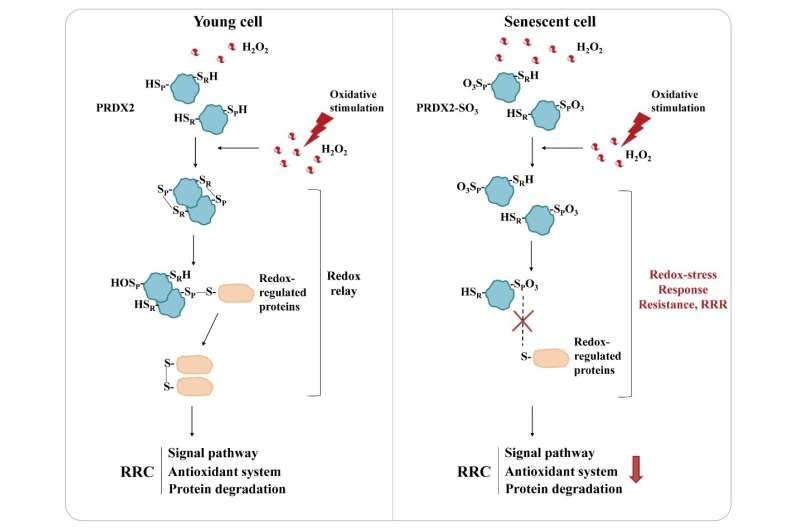This article has been reviewed according to Science X's editorial process and policies. Editors have highlighted the following attributes while ensuring the content's credibility:
fact-checked
peer-reviewed publication
trusted source
proofread
Redox-stress response resistance mediated by hyperoxidation of peroxiredoxin 2 in senescent cells

Aging is closely related to redox stress. The free radical theory of aging believes that free radicals cause aging by oxidative damage to macromolecules. However, the clinical application of antioxidants to anti-aging is still a challenge more than half a century on, which calls into question the free radical theory of aging.
Most previous studies on redox and aging focused on the level of ROS at rest, but little attention has been paid to the dynamic responsiveness of redox stimuli. Chang Chen and a team from Institute of Biophysics, Chinese Academy of Sciences, proposed a new concept of Redox-stress Response Capacity (RRC) in a previous study, and found that the decline of RRC is an essential characteristic of aging. So why does the RRC decrease during aging?
The research group discovered the phenomenon of insulin resistance-like "Redox-stress Response Resistance (RRR)" in senescent cells, and revealed a new mechanism of PRDX2 hyperoxidation leading to RRR. The paper entitled, "Redox-stress response resistance (RRR) mediated by hyperoxidation of peroxiredoxin 2 in senescent cells," was published online in Science China Life Sciences.
Using replicative senescence cells and nematodes as models, the research fellows identified that peroxiredoxin 2 (PRDX2), as a H2O2 sensor, was involved in mediating RRC. In response to stimulation, young cells produce H2O2 and transduce signals through a PRDX2-based redox relay, thereby activating RRC. PRDX2 knockdown led to a decline of RRC and accelerated senescence in fibroblasts and prdx-2 mutant C. elegans also shows decreased RRC.
The mechanism study showed that hyperoxidation of PRDX2 increased in senescent cells and old C. elegans, and the sensor activity of PRDX2 decreased. Moreover, the level of PRDX2 hyperoxidation also increased in old C. elegans. Simultaneous overexpression of both PRDX2 and Sulfiredoxin (SRX) rescued the reduced RRC and delayed senescence.
Treatment of young cells with a high level of H2O2 to induce higher level of PRDX2-SO3 resulted in mimicking the RRC decline in senescent cells. These results indicate that the increase in PRDX2 hyperoxidation in senescent cells led to decreased sensor activity, showing resistance characteristic of low H2O2 sensitivity and resulting in decreased RRC. This resistance characteristic in senescent cells is similar to insulin resistance due to the lower insulin receptor sensitivity, so researchers named it "Redox-stress Response Resistance, RRR."
The similarity between RRR and insulin resistance in phenotype, consequences and mechanisms were further discussed.
- The phenotypes of resistance are similar. In insulin-resistant diabetic patients, the plasma insulin level is high, but the target organ is not sensitive to insulin and thus, the insulin signaling pathway is blocked; similarly, in senescent cells, the H2O2 level is high, but the cell is not sensitive to H2O2 and thus, the redox signaling pathway is blocked.
- The consequences of resistance are similar. Insulin resistance leads to decreased efficiency of glucose uptake and utilization and an increase in blood glucose levels, and RRR leads to decreased activation of the antioxidant system and protein degradation and an increase in damaged protein accumulation.
- The mechanisms of resistance are also comparable. Decreased activity of the insulin receptor leads to that the target organ is not sensitive to insulin; in senescent cell, decreased sensor activity of PRDX2 due to PRDX2 hyperoxidation results in insensitivity of cells to H2O2.
In conclusion, RRR in senescent cells is an important new discovery that reveals the dynamic characteristics of aging and also explains the decline of RRC during aging. Different from the free radical theory of aging, this study reveals a new mechanism of redox regulation of aging from the perspective of maintaining physiological function of redox stress, and proposes that delaying RRR may be an effective new strategy to intervene in aging, providing a new idea for delaying aging, which is of great significance.
More information: Jiao Meng et al, Redox-stress response resistance (RRR) mediated by hyperoxidation of peroxiredoxin 2 in senescent cells, Science China Life Sciences (2023). DOI: 10.1007/s11427-022-2301-4



















